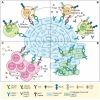Immunobiology and conflicting roles of the human NKG2D lymphocyte receptor and its ligands in cancer
- PMID: 23913973
- PMCID: PMC3736343
- DOI: 10.4049/jimmunol.1301071
Immunobiology and conflicting roles of the human NKG2D lymphocyte receptor and its ligands in cancer
Abstract
Cancers adopt diverse strategies to safeguard their survival, which often involve blinding or incapacitating the immune response, thereby gaining battleground advantage against the host. In immune responses against cancer, an important stimulatory lymphocyte receptor is NKG2D because the tumor-associated expression of its ligands promotes destruction of malignant cells. However, with advanced human cancers profound changes unfold wherein NKG2D and its ligands are targeted or exploited for immune evasion and suppression. This negative imprinting on the immune system may be accompanied by another functional state wherein cancer cells coopt expression of NKG2D to complement the presence of its ligands for self-stimulation of tumor growth and presumably malignant progression. This review emphasizes these conflicting functional dynamics at the immunity-cancer biology interface in humans, within an overview of the immunobiology of NKG2D and mechanisms underlying the regulation of its ligands in cancer, with reference to instructive clinical observations and translational approaches.
Figures

References
-
- Nausch N, Cerwenka A. NKG2D ligands in tumor immunity. Oncogene. 2008;27:5944–5958. - PubMed
-
- Gonzalez S, Lopez-Soto A, Suarez-Alvarez B, Lopez-Vazquez A, Lopez-Larrea C. NKG2D ligands: key targets of the immune response. Trends Immunol. 2008;29:397–403. - PubMed
-
- Gonzalez S, Groh V, Spies T. Immunobiology of human NKG2D and its ligands. Curr. Top. Microbiol. Immunol. 2006;298:121–138. - PubMed
Publication types
MeSH terms
Substances
Grants and funding
LinkOut - more resources
Full Text Sources
Other Literature Sources

